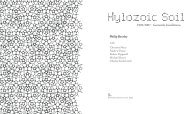The Inner Studio - Riverside Architectural Press
The Inner Studio - Riverside Architectural Press
The Inner Studio - Riverside Architectural Press
You also want an ePaper? Increase the reach of your titles
YUMPU automatically turns print PDFs into web optimized ePapers that Google loves.
THE INNER STUDIO<br />
Psychology has an enormous appetite for architectural<br />
language. Instead of using this language to describe physical things,<br />
psychology uses it to describe the psyche, the “place” where our<br />
conscious and unconscious mind are thought to reside. I began to<br />
wonder if the power and wonder of architectural phenomena rests<br />
in their ability to point to structures that reside in the immeasurable<br />
world of our psyche. In the world of the psyche, as in<br />
architecture, the primary dialogue concerns the relationship and<br />
boundary between inside and outside. <strong>Inner</strong> and outer may seek<br />
congruence or be split. Where inner and outer touch, psychology<br />
uses words like “façade,” “boundary,” “border,” “threshold,” and<br />
“wall.” Psychologically speaking, walls may be transparent, rigid,<br />
divided, or fragile. Boundaries may be clear or need strengthening.<br />
<strong>The</strong>y are subject to breaking down or may suffer a collapse, but<br />
they can also be rebuilt or repaired. Inside and outside are always<br />
interacting, and we depend on these invisible structures to make<br />
sense of the world. <strong>The</strong>se psychic constructions may be functional<br />
or dysfunctional, they may feel heavy or light, or they may cause us<br />
to take flight, feel grounded, or feel out of place.<br />
In the psychological world we commonly describe our moods<br />
with reference to space. “I’m feeling down,” “I’m feeling up,” “She’s<br />
beside herself with anger,” “You’re driving me up the wall,” “She’s<br />
feeling open” or “He’s always closed down.” We have an innate<br />
sense of ourselves as the “center” and use symbolic ideas about<br />
place to help us communicate our moods. We have established,<br />
through descriptions of psychological space, experiences that we<br />
bring to the built world.<br />
Psychological language has moved quickly into every corner of<br />
our conversations because we need its capacity for describing the<br />
immeasurable yet tactile experience of moods. Words like “split,”<br />
“compensation,” “sublimation,” “fragments,” “nightmare,” “light”<br />
and “shadow” are found in descriptions of both the built world and<br />
therapeutic case histories. <strong>The</strong>y have been absorbed into architecture<br />
with the meaning acquired in psychological discourse.<br />
<strong>The</strong> education of designers currently begins and ends with the<br />
rational world. We might believe that this was sufficient if we did<br />
not have the evidence of a troubling state of affairs in the built<br />
6





